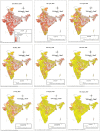COVID-19 outbreak and Urban dynamics: regional variations in India
- PMID: 33678946
- PMCID: PMC7925257
- DOI: 10.1007/s10708-021-10394-6
COVID-19 outbreak and Urban dynamics: regional variations in India
Abstract
India was the second highest COVID-19 affected country in the world with 2.1 million cases by 11th August. This study focused on the spatial transmission of the pandemic among the 640 districts in India over time, and aimed to understand the urban-centric nature of the infection. The connectivity context was emphasized that possibly had inflicted the outbreak. Using the modes of transmission data for the available cases, the diffusion of this disease was explained. Metropolitans contributed three-fourths of total cases from the beginning. The transport networks attributed significantly in transmitting the virus from the urban containment zones. Later, there was a gradual shift of infections from urban to rural areas; however, the numbers kept increasing in the former. The massive reverse migration after lockdown spiked the infected cases further. Districts with airports reported more with influx of international passengers. A profound east-west division in April with higher infections in the southern and western districts existed. By mid-May eastern India saw a steep rise in active cases. Moran's I analysis showed a low autocorrelation initially which increased over time. Hotspot clustering was observed in western Maharashtra, eastern Tamil Nadu, Gujarat and around Kolkata by the second week of August. The diffusion was due to travel, exposure to infected individuals and among the frontline workers. Spatial regression models confirmed that urbanization was positively correlated with higher incidences of infections. Transit mediums, especially rail and aviation were positively associated. These models validated the crucial role of spatial proximity in diffusion of the pandemic.
Keywords: COVID-19; Cities; Modes of transmission; Spatial regression models; Travel networks; Urban-centric.
© The Author(s), under exclusive licence to Springer Nature B.V. part of Springer Nature 2021.
Conflict of interest statement
Conflicts of interestThe authors declare that there was no potential conflicts of interest while conducting the research or preparing the manuscript. No research grant was obtained from funding agencies to prepare this manuscript. This study has been carried out using secondary data and did not involve any human participants or animals. All the data are available in the public domain thus, no Informed consent was required.
Figures




Similar articles
-
Impact of international travel dynamics on domestic spread of 2019-nCoV in India: origin-based risk assessment in importation of infected travelers.Global Health. 2020 May 12;16(1):45. doi: 10.1186/s12992-020-00575-2. Global Health. 2020. PMID: 32398137 Free PMC article.
-
District level correlates of COVID-19 pandemic in India during March-October 2020.PLoS One. 2021 Sep 30;16(9):e0257533. doi: 10.1371/journal.pone.0257533. eCollection 2021. PLoS One. 2021. PMID: 34591892 Free PMC article.
-
District-level heterogeneity in overweight or obesity among women of reproductive age: A geo-spatial analysis in India.PLoS One. 2023 Aug 17;18(8):e0290020. doi: 10.1371/journal.pone.0290020. eCollection 2023. PLoS One. 2023. PMID: 37590188 Free PMC article.
-
Universal screening for SARS-CoV-2 infection: a rapid review.Cochrane Database Syst Rev. 2020 Sep 15;9(9):CD013718. doi: 10.1002/14651858.CD013718. Cochrane Database Syst Rev. 2020. PMID: 33502003 Free PMC article.
-
Impact of COVID-19 pandemic on road safety in Tamil Nadu, India.Int J Inj Contr Saf Promot. 2022 Jun;29(2):265-277. doi: 10.1080/17457300.2021.2007134. Epub 2021 Dec 1. Int J Inj Contr Saf Promot. 2022. PMID: 34852726 Review.
Cited by
-
Community Preparedness and Practices for Prevention and Control of COVID-19 (COP-COVID): An Assessment from Rural Northern India.Disaster Med Public Health Prep. 2021 Aug 4;17:e29. doi: 10.1017/dmp.2021.255. Disaster Med Public Health Prep. 2021. PMID: 34344491 Free PMC article.
-
Spatiotemporal pattern of Covid-19 outbreak in Turkey.GeoJournal. 2023;88(2):1305-1316. doi: 10.1007/s10708-022-10666-9. Epub 2022 Jun 16. GeoJournal. 2023. PMID: 35729953 Free PMC article.
-
Evolution of the pandemic: Analysis of demographic characteristics of COVID-19-infected patients during its two waves in Gwalior district of central India.J Family Med Prim Care. 2022 Apr;11(4):1314-1321. doi: 10.4103/jfmpc.jfmpc_1189_21. Epub 2022 Mar 18. J Family Med Prim Care. 2022. PMID: 35516675 Free PMC article.
-
Spatiotemporal analysis of the morbidity of global Omicron from November 2021 to February 2022.J Med Virol. 2022 Nov;94(11):5354-5362. doi: 10.1002/jmv.28013. Epub 2022 Jul 29. J Med Virol. 2022. PMID: 35864556 Free PMC article.
-
Propagation Analysis of COVID-19: An SIR Model-Based Investigation of the Pandemic.Arab J Sci Eng. 2021 Aug 10:1-13. doi: 10.1007/s13369-021-05904-0. Online ahead of print. Arab J Sci Eng. 2021. PMID: 34395158 Free PMC article.
References
-
- Anselin L, Syabri I, Kho Y. GeoDa: An introduction to spatial data analysis. Geographical Analysis. 2006;38(1):5–22. doi: 10.1111/j.0016-7363.2005.00671.x. - DOI
-
- Avetisyan, S. (2020). Coronavirus and urbanisation: do pandemics are anti-urban? Retrieved from https://papers.ssrn.com/sol3/papers.cfm?abstract_id=3584395.
LinkOut - more resources
Full Text Sources
Other Literature Sources
Miscellaneous
